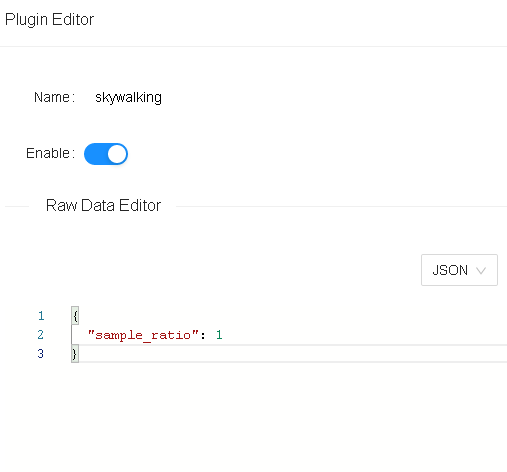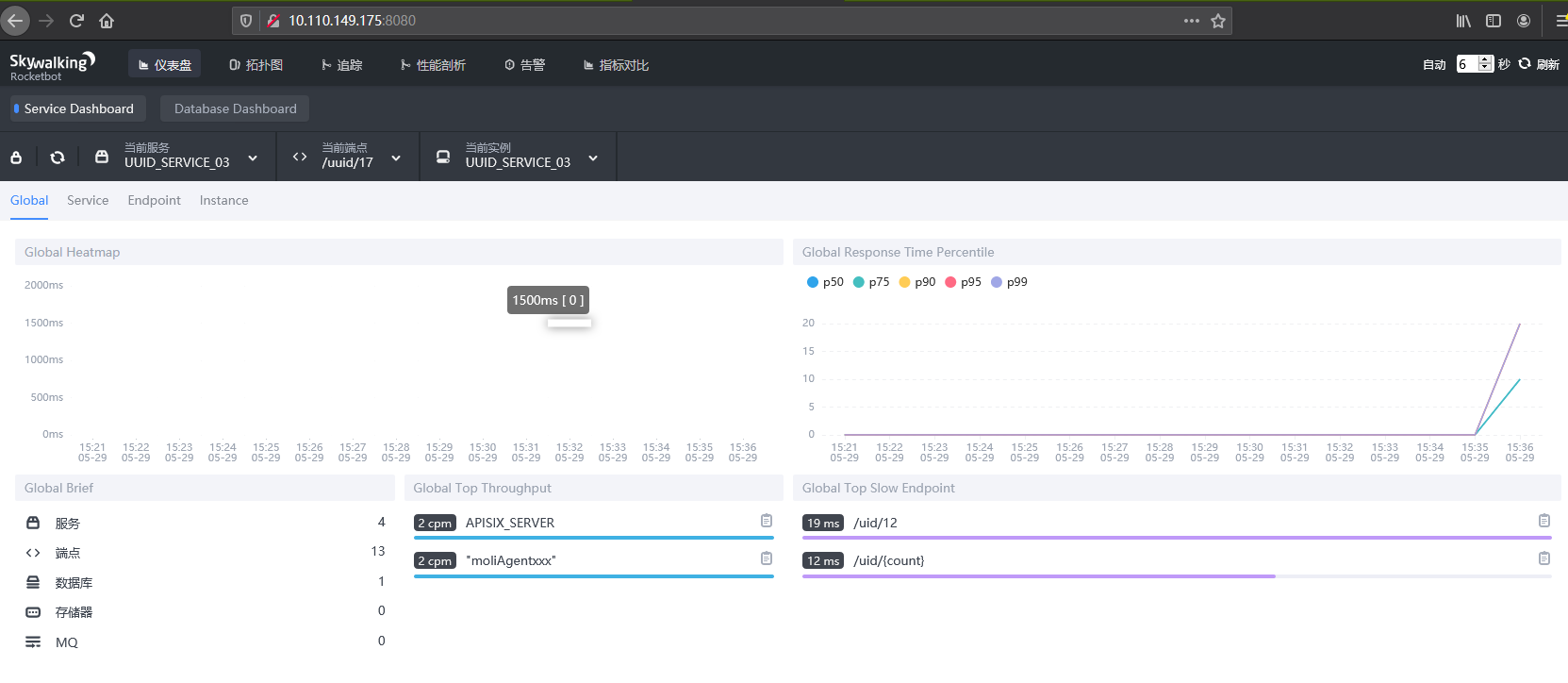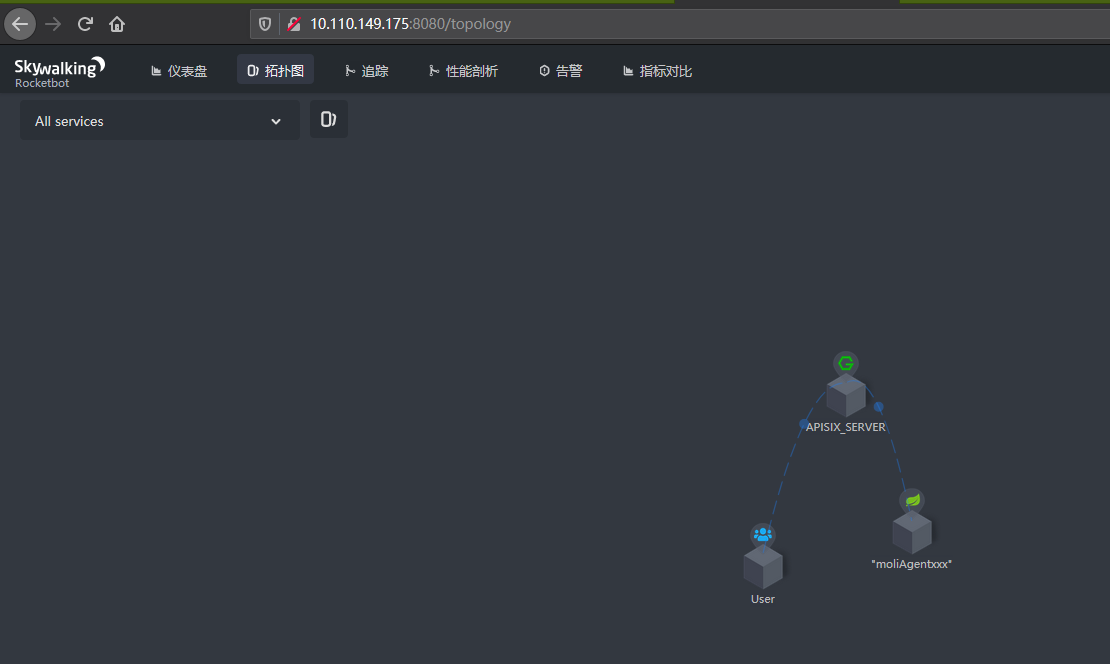skywalking
Summary#
Name#
Skywalking uses its native Nginx LUA tracer to provide tracing, topology analysis, and metrics from service and URI perspective. The skywalking server can supports both http and grpc protocols. The APISIX client only support http protocols.
Attributes#
| Name | Type | Requirement | Default | Valid | Description |
|---|---|---|---|---|---|
| sample_ratio | number | required | 1 | [0.00001, 1] | the ratio of sample |
How To Enable#
First of all, enable the skyWalking plugin in the config.yaml:
# Add this in config.yamlplugins: - ... # plugin you need - skywalkingThen reload APISIX, a background timer will be created to report data to skywalking server.
Here's an example, enable the skywalking plugin on the specified route:
curl http://127.0.0.1:9080/apisix/admin/routes/1 -H 'X-API-KEY: edd1c9f034335f136f87ad84b625c8f1' -X PUT -d '{ "methods": ["GET"], "uris": [ "/uid/*" ], "plugins": { "skywalking": { "sample_ratio": 1 } }, "upstream": { "type": "roundrobin", "nodes": { "10.110.149.175:8089": 1 } }}'You also can complete the above operation through the web interface, first add a route, then add skywalking plugin:

How to set endpoint#
We can set the endpoint by specified the configuration in conf/config.yaml.
| Name | Type | Default | Description |
|---|---|---|---|
| service_name | string | "APISIX" | service name for skywalking reporter |
| service_instance_name | string | "APISIX Instance Name" | service instance name for skywalking reporter, set it to $hostname to get local hostname directly. |
| endpoint_addr | string | "http://127.0.0.1:12800" | the http endpoint of Skywalking, for example: http://127.0.0.1:12800 |
| report_interval | integer | use the value in the skywalking client library | the report interval, in seconds |
Here is an example:
plugin_attr: skywalking: service_name: APISIX service_instance_name: "APISIX Instance Name" endpoint_addr: http://127.0.0.1:12800Test Plugin#
Run Skywalking Example#
e.g.#
Run Skywalking Server:
By default, use H2 storage, start skywalking directly
sudo docker run --name skywalking -d -p 1234:1234 -p 11800:11800 -p 12800:12800 --restart always apache/skywalking-oap-server:8.3.0-es6Of Course, you can use Elasticsearch storage
Firstly, you should install Elasticsearch:
sudo docker run -d --name elasticsearch -p 9200:9200 -p 9300:9300 --restart always -e "discovery.type=single-node" elasticsearch:6.7.2You can install ElasticSearch management page: elasticsearch-hq(Optional)
sudo docker run -d --name elastic-hq -p 5000:5000 --restart always elastichq/elasticsearch-hqRun skywalking server:
sudo docker run --name skywalking -d -p 1234:1234 -p 11800:11800 -p 12800:12800 --restart always --link elasticsearch:elasticsearch -e SW_STORAGE=elasticsearch -e SW_STORAGE_ES_CLUSTER_NODES=elasticsearch:9200 apache/skywalking-oap-server:8.3.0-es6
Skywalking WebUI:
Run SkyWalking webUI Server:
sudo docker run --name skywalking-ui -d -p 8080:8080 --link skywalking:skywalking -e SW_OAP_ADDRESS=skywalking:12800 --restart always apache/skywalking-uiOpen the webUI of skywalking: You can open dashboard with a browser: http://10.110.149.175:8080. It will be a successful install as follow:

Test:
Access to upstream services through access apisix:
$ curl -v http://10.110.149.192:9080/uid/12HTTP/1.1 200 OKOK...Open the webUI of skyWalking:
http://10.110.149.175:8080/You can see the topology of all service\
 \
You can also see the tracer of all service\
\
You can also see the tracer of all service\

Disable Plugin#
When you want to disable the skyWalking plugin on a route/service, it is very simple, you can delete the corresponding json configuration in the plugin configuration, no need to restart the service, it will take effect immediately:
$ curl http://127.0.0.1:9080/apisix/admin/routes/1 -H 'X-API-KEY: edd1c9f034335f136f87ad84b625c8f1' -X PUT -d '{ "methods": ["GET"], "uris": [ "/uid/*" ], "plugins": { }, "upstream": { "type": "roundrobin", "nodes": { "10.110.149.175:8089": 1 } }}'The skywalking plugin has been disabled now. It works for other plugins.
If you want to disable skywalking plugin totally, for example, stop the background report timer,
you need to comment out in the config.yaml:
plugins: - ... # plugin you need #- skywalkingAnd then reload APISIX.
Upstream services(Code With SpringBoot)#
package com.lenovo.ai.controller;
import org.springframework.web.bind.annotation.PathVariable;import org.springframework.web.bind.annotation.RequestMapping;import org.springframework.web.bind.annotation.RestController;import javax.servlet.http.HttpServletRequest;
/** * @author cyxinda * @create 2020-05-29 14:02 * @desc skywalking test controller **/@RestControllerpublic class TestController { @RequestMapping("/uid/{count}") public String getUidList(@PathVariable("count") String countStr, HttpServletRequest request) { System.out.println("counter:::::-----"+countStr); return "OK"; }}Configuring the skywalking agent, when starting the service. update the file of agent/config/agent.config
agent.service_name=yourservernamecollector.backend_service=10.110.149.175:11800Run the script:
nohup java -javaagent:/root/skywalking/app/agent/skywalking-agent.jar \-jar /root/skywalking/app/app.jar \--server.port=8089 \2>&1 > /root/skywalking/app/logs/nohup.log &